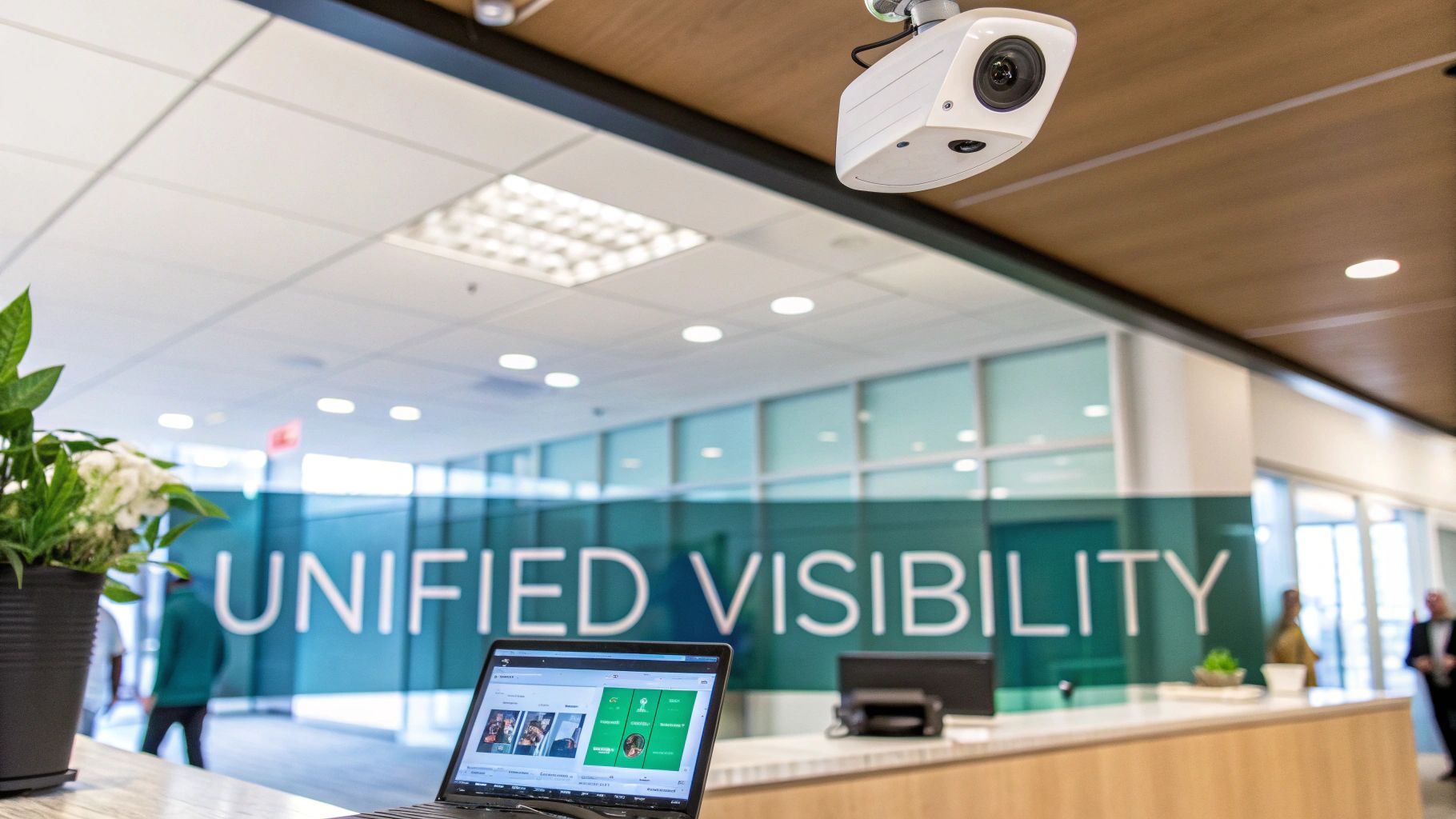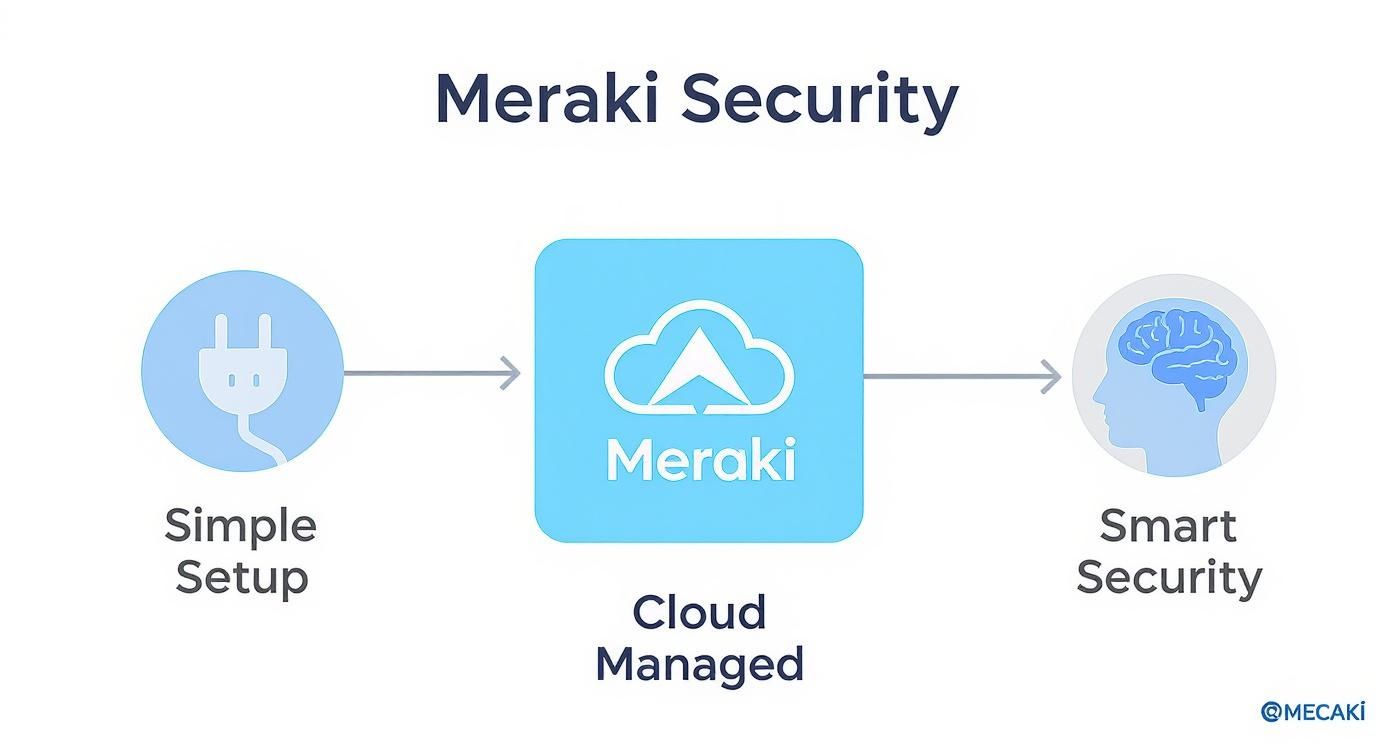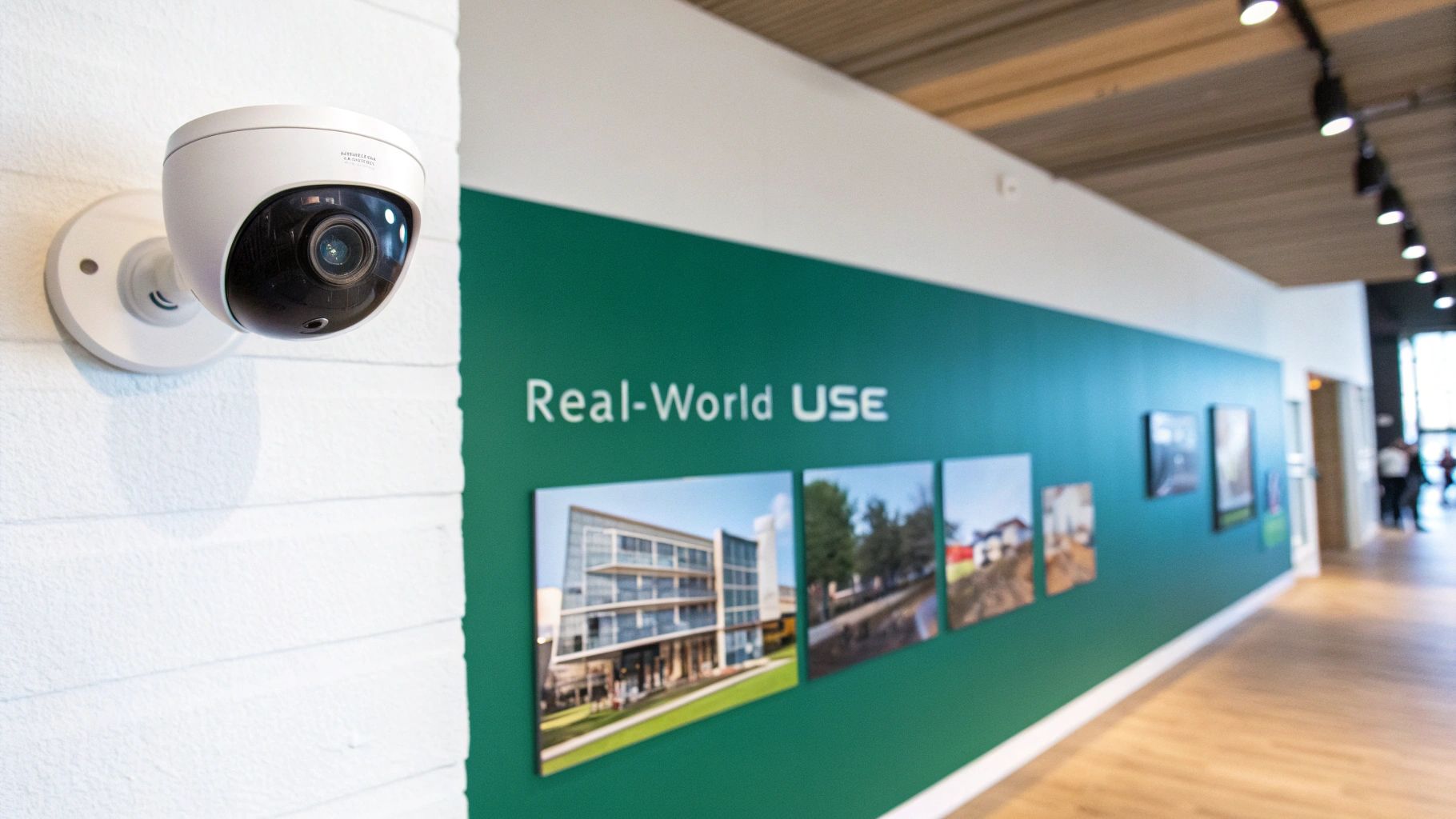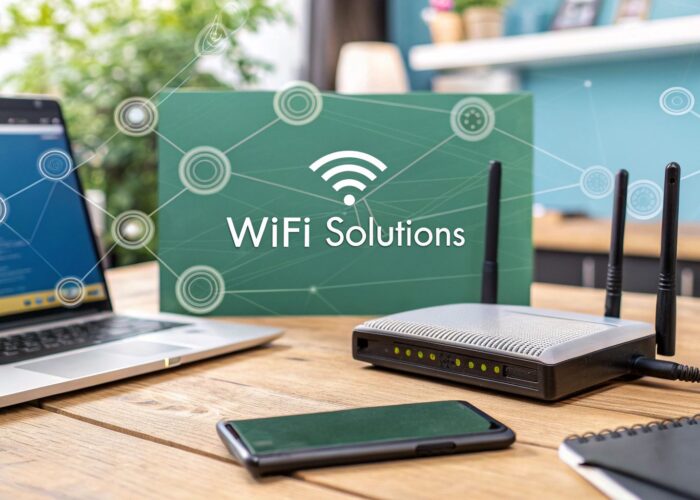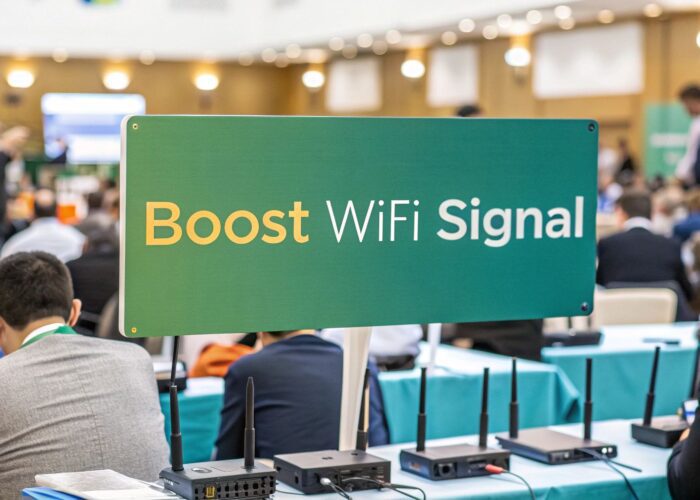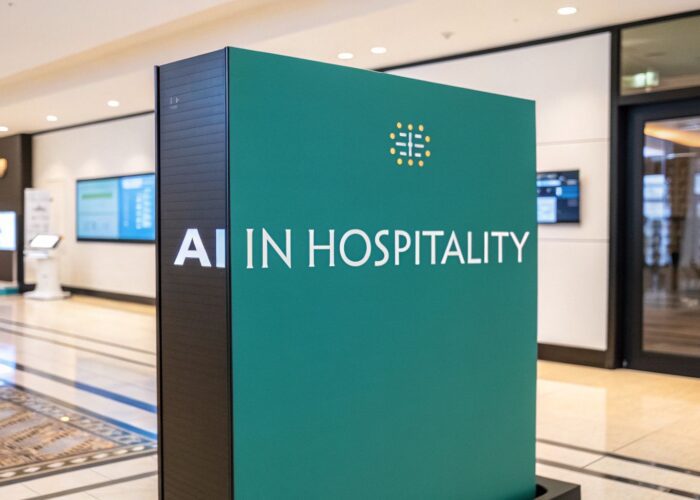Hey there! Welcome to the future of physical security, where a Meraki security camera isn't just a camera—it's the friendly, intelligent heart of a smart, cloud-powered ecosystem from Cisco built for simplicity and serious capability. Let's chat about moving beyond just hitting "record." This is about building an intelligent, scalable, and genuinely easy-to-manage security system for your business, whether you're in education, retail, or a busy corporate office.
Welcome to Smarter Business Security
Let's be honest, traditional video surveillance can be a real headache. You're often stuck with bulky on-site recorders, confusing setups, and a bunch of different systems that refuse to play nicely together. Cisco Meraki threw that old playbook out the window. Their approach is refreshingly simple: plug it in, and you're practically done.
Every Meraki security camera is managed from a single, clean dashboard. That means you can deploy, monitor, and manage your entire camera network from anywhere with an internet connection. This centralized cloud management is a game-changer, eliminating the need to juggle multiple vendors and complex setups, which in turn frees up your IT team for more important work.
Simplifying Security for Every Sector
The beauty of the Cisco Meraki platform is that it just works, whether you're a school in the education sector, a bustling retail shop, or a corporate office navigating a Bring Your Own Device (BYOD) policy. The cameras are designed to integrate perfectly with other Meraki gear, especially their best-in-class Wi-Fi access points.
Think about it: you can manage your network access and physical security from the same screen. This is where things get really interesting. You can start pairing camera analytics with guest Wi-Fi data from a Captive Portal to get a much clearer picture of how people are actually using your space.
The real magic of the Cisco Meraki ecosystem is its power to unify. By bringing security cameras and network management under one roof, businesses get a level of insight and control that used to be incredibly complicated and expensive to pull off.
The Meraki platform truly shines when you look at its core advantages. It's a system designed from the ground up to reduce complexity and maximize efficiency.
Meraki Security Camera Key Advantages at a Glance
| Feature | Benefit for Your Business |
|---|---|
| Centralized Cloud Management | Control all cameras from a single web-based dashboard, from anywhere in the world. |
| Plug-and-Play Deployment | Cameras are online and recording in minutes with zero-touch provisioning. No complex setup. |
| No NVRs/DVRs Needed | Onboard solid-state storage eliminates the need for bulky, failure-prone local recorders. |
| Powerful On-Camera Analytics | Built-in machine learning provides insights like motion heatmaps and object detection without extra servers. |
| Seamless Firmware Updates | Automatic updates ensure your cameras are always secure and have the latest features. |
| Granular Access Controls | Easily define who can view which cameras and what actions they can perform. |
This isn't just about cool features; it's about making your security operations smarter and more efficient across the board.
Tangible Business Impact
These efficiency boosts aren't just talk; they have a real impact on the bottom line. A Forrester Consulting study found that businesses using Meraki MV cameras could see a return on investment (ROI) of 43%. Even more impressively, some cut the time spent accessing and sharing video footage by up to 98%. That’s the power of ditching traditional DVRs and NVRs for a cloud-first workflow.
Of course, any new system is an investment. For a better understanding of what goes into a project like this, it's helpful to look at the typical cost of security cameras installation.
This smart, unified approach even extends to how you manage network access. When you pair the cameras with Captive Portals that support Authentication Solutions like IPSK (Identity Pre-Shared Key) or EasyPSK, you can give guests and employees secure, hassle-free Wi-Fi. This synergy between physical security and network access is what really makes the Cisco Meraki platform stand out. To see just how powerful they can be, you can explore our deep dive into these MV cloud-managed security cameras.
How Meraki Cameras Redefine Video Analytics
Let's get one thing straight: a Meraki security camera is not just another device for recording video. It's an intelligent sensor, and its real power lies in its ability to gather and analyze data on the spot. The secret ingredient here is MV Sense, a technology that lets the camera process information directly on the device itself. This is way beyond basic motion detection.
Instead of just capturing footage and sending it off to a server, these cameras are thinking for themselves. They can handle complex jobs like counting people, generating motion heatmaps, and identifying vehicles—all without bogging down your network with heavy video streams. This "edge processing" approach means your bandwidth is free for everything else that matters.
Turning Video into Business Intelligence
Think about what happens when a standard security camera becomes a source of genuine business intelligence. A retail shop, for instance, could use heatmaps to see exactly where customers linger, helping them rethink product layouts and slash wait times at checkout. In a modern corporate office with a BYOD policy, you could track how often meeting rooms and desks are actually used to make smarter decisions about hybrid work arrangements.
This is precisely what the Cisco Meraki platform delivers. It closes the gap between physical security and operational smarts, giving you a crystal-clear picture of how people interact with your spaces.
A Meraki security camera processes analytics right on the device, turning raw video into structured, usable data. This empowers businesses to make data-driven decisions that can sharpen efficiency, elevate the customer experience, and improve safety.
This infographic breaks down the core concepts of the Meraki security ecosystem, showing just how simple the setup, cloud management, and intelligent security features are.
You can see how these three pillars—simplicity, cloud control, and smart security—come together to form a system that’s both powerful and easy to manage. It’s a combination that works incredibly well across a huge range of industries. To see how these features translate into real-world results, take a look at our guide to MV camera analytics.
Analytics That Work with Your Network
The real magic happens when you connect these analytics to your Wi-Fi network. By combining camera data with a Captive Portal and secure Authentication Solutions, you can paint an incredibly detailed picture of user behavior. This is a game-changer for sectors like education and retail.
For example, a university can use people-counting data from cameras to monitor classroom capacity. At the same time, it can use IPSK (Identity Pre-Shared Key) or EasyPSK to give students and staff secure, individual access to the network. This combination of physical monitoring and network security creates a much safer and more intelligent campus.
The appetite for this kind of smart solution is growing fast. The global surveillance camera market is expected to jump from USD 33.6 billion in 2022 to a staggering USD 72.4 billion by 2030. With its intuitive dashboard and cloud-native design, Cisco Meraki is perfectly aligned with this industry-wide shift toward AI-driven analytics. You can read the full research on the surveillance camera market to get a sense of this growth. It all points to one thing: businesses need systems that don't just record what happens, but help them understand why it happens. That's exactly what Meraki's approach delivers.
Unifying Your Network With Meraki Wi-Fi and Cameras
The true magic of the Cisco Meraki platform isn't in any single device; it's how they all work together. A Meraki security camera is a solid piece of hardware on its own, but it becomes something else entirely when it’s part of a fully integrated ecosystem, especially when paired with Meraki’s world-class Wi-Fi. This isn't about juggling two separate systems. It's about creating one seamless, intelligent infrastructure.
Picture this: you get an alert about a network slowdown in one corner of your building. With a traditional setup, you’d pull up network logs on one screen and then try to find the right video footage from a completely separate security system, hoping the timestamps line up. With Meraki, you see the network event and the video from that exact time and location, all in one dashboard. That kind of visibility completely changes the game for troubleshooting and security.
A Connected Ecosystem for Today's Demands
This unified approach is a game-changer for any place where physical security and network access are equally important. Think of a busy retail store, a dynamic school in the education sector, or a corporate office managing a BYOD (Bring Your Own Device) policy. In every one of these scenarios, having your network and cameras "speak the same language" is a massive advantage.
In a retail store, for instance, you can use the Wi-Fi network with a Captive Portal to engage with shoppers while your cameras are simultaneously analyzing foot traffic. It’s about creating a single experience that’s both secure for you and insightful for your business. For a deeper look, check out this guide on simplifying smart camera deployments with wireless to see how these pieces fit together.
The core value of the Meraki ecosystem is its ability to break down silos. When your Wi-Fi and security cameras operate as one, you gain a holistic view that simplifies management, accelerates incident response, and unlocks deeper operational insights.
This integration makes for smarter, more context-aware security. You're no longer just reacting to alarms; you're proactively managing your environment with a complete picture of what's happening.
Simplifying Access and Security
One of the most powerful, everyday uses of this unified system is managing who gets on your network. With modern Authentication Solutions like IPSK (Identity Pre-Shared Key) or EasyPSK, you can hand out secure, individual Wi-Fi access to employees, students, or guests without the nightmare of managing complex passwords.
Here’s how that ties directly into your cameras:
- Corporate BYOD: An employee connects their phone to the network using a unique IPSK. If a security incident happens, you can instantly correlate that specific user’s network activity with video from nearby cameras. No more guesswork.
- Education Campuses: Students get unique credentials for Wi-Fi, while cameras keep an eye on common areas. This layered approach creates a much safer campus where both the digital and physical spaces are locked down.
- Retail Guest Wi-Fi: Customers sign in through a Captive Portal, giving you great marketing data. At the same exact time, your Meraki security camera is tracking footfall and dwell times, giving you the full story of the customer journey.
By combining rock-solid Wi-Fi management with intelligent video, the Cisco Meraki platform delivers a single solution that simplifies IT, tightens security, and gives you the data needed to make smarter decisions.
Tying It All Together: Wi-Fi and Camera Insights
Let's connect the dots. A Meraki security camera gives you an incredible look into what’s happening in your physical spaces, but what if you could layer that with data from your Wi-Fi network? This is where the real magic of the Cisco Meraki ecosystem kicks in, transforming your guest Wi-Fi from a simple amenity into a powerhouse for understanding visitor behavior.
When you use a Captive Portal, you're creating a branded, welcoming front door to your network. But it’s so much more than just a login screen. It's your first real chance to learn about who is in your space, whether that's a customer in a retail store, a student on a university campus in the education sector, or a guest in a corporate office.
Secure and Simple Wi-Fi Authentication
Let's be honest, managing network access can be a real headache, especially in busy places with a constant flow of different users. This is where modern Authentication Solutions are a lifesaver. Instead of passing around a single password that eventually gets compromised, you can use much smarter methods.
- IPSK (Identity Pre-Shared Key): Think of this as giving each person or device their own unique key to the Wi-Fi. It’s perfect for BYOD corporate environments because you can easily grant and revoke access for one employee without disrupting everyone else.
- EasyPSK: This takes the IPSK idea and simplifies it for massive deployments, like a sprawling university campus or a multi-location retail chain. It handles the heavy lifting of creating and distributing all those unique keys automatically.
These solutions offer a secure, smooth connection for everyone. Guests get online without a fuss, and your internal network remains safely walled off. This clean, secure Wi-Fi experience is the foundation for building a truly smart environment.
Combining Wi-Fi and Camera Analytics
Okay, so how does this all tie back to your Meraki security camera? When you start combining the data from your Wi-Fi network with the analytics from your cameras, you unlock a completely new level of understanding.
Picture yourself managing a retail store. Your Captive Portal tells you who is connecting to the Wi-Fi—are they a new or returning customer? At the exact same time, your cameras are generating heatmaps that show you where these customers are spending the most time. All of a sudden, you have a complete map of the customer journey, from the moment they log in to the network to their physical path through your store.
By layering Wi-Fi connection data with visual camera analytics, businesses can move from simple observation to true behavioral insight. You're not just seeing foot traffic; you're understanding the people behind the patterns.
This synergy lets you make smart decisions that directly improve the customer experience. You can redesign store layouts based on real traffic flows, adjust staffing for peak hours, or even push targeted promotions to loyal visitors. This is precisely where you can dig deeper into customer experience personalization.
By fully integrating your Cisco network infrastructure, you create a powerful feedback loop. The Wi-Fi authenticates and identifies the "who," while the camera observes and analyzes the "what" and "where." Together, they deliver the actionable intelligence you need to sharpen operations and create better environments for everyone. This intelligent combination is what makes a Meraki-powered solution so effective.
Meraki Cameras in Action Across Industries
It’s one thing to talk about features and specs, but the true measure of a Meraki security camera is how it performs in the wild. The Cisco Meraki platform isn't some rigid, one-size-fits-all product. Its real strength lies in its flexibility to solve unique problems across different sectors, turning a simple camera into a powerful strategic tool.
Let's dive into a few examples of how industries are blending physical security with sharp operational insights. From bustling school corridors to the sales floor of a busy shop, these cameras are doing more than just watching—they’re delivering real, actionable data.
Education: Building a Smarter, Safer Campus
For any school, campus safety is non-negotiable. Education institutions use Meraki cameras to keep an eye on high-traffic zones like entrances, hallways, and common areas. This gives administrators an immediate, crystal-clear view of what's happening. Thanks to the cloud dashboard, security staff can pull up HD footage in seconds to investigate an incident from literally any device.
But it gets better. When you pair the cameras with a secure Wi-Fi network using Authentication Solutions like IPSK or EasyPSK, the whole system becomes far more robust. Schools can lock down network access to authorized students and staff only, creating a secure digital bubble that perfectly complements the physical security from the cameras.
Retail: Fine-Tuning the Shopper Experience
In retail, knowing your customer is the name of the game. A Meraki security camera running MV Sense analytics is like having a secret weapon for business intelligence. Retailers can generate heatmaps to see which displays and aisles are getting the most love, which is invaluable for optimizing store layouts.
Queue management is another huge win. Cameras can be set up to fire off an alert when checkout lines start backing up, letting a manager open another register before customers get frustrated. Combine that with data from a guest Wi-Fi Captive Portal, and you get a full-circle view of the customer journey. You can see this exact strategy at work in our Stumptown Coffee Roasters case study.
By turning raw video into hard data—like dwell times and foot traffic patterns—Meraki cameras help retailers swap guesswork for a data-backed strategy. The result is a better shopping experience and a healthier bottom line.
Corporate: Securing the Modern Workspace
Today's corporate offices are a different beast, with hybrid schedules and BYOD policies creating new security puzzles. Meraki cameras are great for securing access points and sensitive zones, but they also help optimize the office itself. By analyzing occupancy trends, facilities managers can make smarter calls on space utilization, which directly informs hybrid work policies and even long-term real estate decisions.
This data-driven approach is essential when office usage is constantly in flux. While Cisco is a major player in security analytics, its real edge is the integrated, cloud-first platform. The entire video surveillance-as-a-service (VSaaS) market is set to hit USD 17.8 billion by 2032, and Meraki is perfectly positioned to capture that demand. You can get a broader look at the surveillance market to see just how big this trend is becoming.
Your Meraki Security Camera Questions Answered
Whenever you’re getting to grips with new tech, questions are bound to pop up. To cut through the noise, we’ve put together answers to some of the most common things people ask about the Meraki security camera ecosystem. My goal here is to give you clear, practical answers so you know exactly how this system performs in the real world.
Let's dive into the nuts and bolts of deploying a Cisco Meraki solution, from storage to what happens when the network goes down.
How Does Meraki Handle Video Storage Without a Local NVR?
This is probably one of the biggest—and best—differences in how Meraki thinks about video security. Instead of routing everything to a separate Network Video Recorder (NVR), every single Meraki security camera comes with high-endurance, solid-state storage built right in. The camera saves all its recordings directly onto itself.
This "edge storage" approach is a game-changer. It completely eliminates the need for a clunky, expensive NVR, which not only streamlines your installation but also removes a massive single point of failure. In a traditional setup, if the NVR dies, you lose your recording capabilities across the board. With Meraki, each camera is its own self-contained recording powerhouse.
For long-term storage, you can archive important clips to the cloud from the dashboard, where they're saved indefinitely. This hybrid model really gives you the best of both worlds: the rock-solid reliability of local recording paired with the easy access of the cloud. It's also incredibly bandwidth-efficient, since you aren't constantly streaming terabytes of footage across your network.
What Happens to My Camera If the Internet Goes Down?
This is where that on-board storage really proves its worth. If your internet connection drops, the Meraki security camera doesn’t skip a beat. It just keeps on recording high-quality video to its internal drive, no interruptions.
As soon as your internet comes back online, the camera automatically syncs everything up with the Meraki cloud. All the footage recorded during the outage appears in your dashboard as if nothing ever happened. You won’t have a single gap in your coverage.
This design guarantees that the little network hiccups that happen to everyone don't create dangerous blind spots in your security. It provides the kind of continuous, reliable surveillance that businesses in retail and education absolutely depend on.
Can I Integrate Meraki Cameras with Other Systems?
Yes, you can, and this is where the platform truly becomes more than just a security tool. Cisco Meraki offers a set of powerful APIs (Application Programming Interfaces) that act as a bridge, letting you connect your cameras to all sorts of other business systems. This opens up a whole world of custom solutions.
Here are a couple of great examples:
- The MV Sense API: This lets you tap into the camera's brain and pull out all the rich analytics data it generates, like people counts or vehicle detections. You could pipe this information into a business intelligence tool to track foot traffic in a store or monitor how meeting rooms are being used in a corporate BYOD environment.
- The Video Streaming API: This gives you the ability to pull live or recorded video feeds into other platforms. While most people love using the Meraki dashboard, this offers the flexibility to integrate video into a custom security console if you have a specific need for it.
This open approach means your Meraki security camera isn't just a siloed security device. It becomes an active data source that can inform and improve everything from your daily operations to your marketing strategy.
This kind of integration is especially powerful when you pair it with Authentication Solutions on your Wi-Fi. By linking data from a Captive Portal login with the camera's analytics, you can build an incredibly detailed picture of customer and guest behavior.
Are Meraki Security Cameras Suitable for Outdoor Use?
Absolutely. Cisco Meraki offers a whole family of cameras specifically engineered to live outside and handle whatever the weather throws at them.
These outdoor models are built tough. They typically carry high IP ratings, like IP67, which means they're fully sealed against dust and can even survive being temporarily submerged in water. They also often have an IK10 vandal-resistance rating, making them strong enough to withstand significant physical impacts.
So whether you need to keep an eye on a parking lot, a school playground, or the entire perimeter of a warehouse, there's an outdoor-rated Meraki security camera up to the task. They offer the same simple, plug-and-play experience and cloud management as the indoor models, giving you consistent, high-quality surveillance everywhere you need it.
Ready to transform your security and gain powerful business insights? Splash Access can help you unlock the full potential of your Cisco Meraki hardware. Explore our solutions today!
